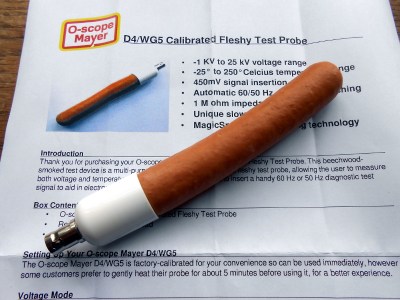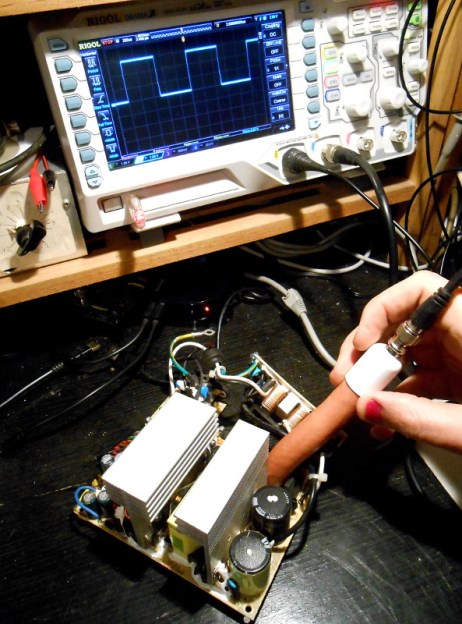![A selection of probes, from [Jim Williams'] Linear Technology app note 72.](https://hackaday.com/wp-content/uploads/2017/03/lt-probe-configurations.jpg?w=400)
The O-scope Mayer D4/WG5 Calibrated Fleshy Test Probe is a roughly 4″ (100mm) long cylinder of their InteliMeat™ synthetic finger analogue terminated with a calibrated matching unit and a BNC socket. In the box aside from the instruction leaflet is a BNC lead through which you can connect it to your oscilloscope.

Holding the probe, it becomes obvious that some thought has been put in to how it should feel to the operator. The weight is about right, it’s slightly flexible but does not feel too heavy, and the outer surface has a smooth skin-like texture. The business end is about the same size as the end of your finger, and is roughly hemispherical rather than terminating in a metal point like other probes. The folks at O-scope Mayer tell us that this is to provide as close as possible an in-use experience to a real finger, and though it felt a little uncomfortable for slightly squeamish Hackaday writers at first, we soon got used to it in practice.
So having unboxed it and examined it, we set about hooking it up to the trusty Rigol 1054z ‘scope. The BNC cable is bi-directional, ingeniously if you wire it one way the probe reads voltage while wiring it the other way makes it read temperature. Using the probe without the BNC cable enables the 50 or 60 Hz injection mode. We found this to be a surprisingly convenient system once we’d got used to it, as it neatly sidesteps the need for any fiddly switches.

The spec says that it has a voltage range of -1 KV to 25 KV, which should be adequate for most fleshy test probe use cases. It has a resolution of 1 mV per volt, giving a maximum output of 25 V for the 25 KV maximum input voltage. On low voltage circuits as you might expect it’s not quite as useful as a regular probe, not surprising given its 1000x attenuation. The ‘scope trace is noisy at these voltages, but it does maintain an accurate voltage reading. For a higher voltage we tried it on a PC switch mode power supply on our bench, and the 350V reading from the “hot” side agreed perfectly with the reading we achieved with the conventional probe. Sadly our bench doesn’t have any significantly high voltage sources so we were unable to test the probe at more than can easily be generated from the usual UK mains supply.
In temperature mode with the BNC cable reversed, the probe delivers 10mV per degree Celcius from -25° to +250°. We were able to test this in a multitude of environments, from a home deep freeze through a glass of ice water, body heat, and a pan of boiling water, to the toasty warm heat sink of our PC power supply with its cooling fan disconnected. At each point its reading agreed with our thermometers, both the mercury-in-glass one we used for the lower temperatures and our venerable radiation pyrometer used for the higher ones. One interesting effect of using the probe with high temperatures was a distinctive and strangely appetizing smell, we’d describe it as somewhere close to the tang of beechwood smoke in the air of a crisp autumn day.

The third mode is that of signal injection, when used without the BNC cable the probe injects a calibrated 450 mV RMS sine wave at either 50 Hz if you are in Europe or 60 Hz if you are in the Americas. This is an extremely useful feature for fault-finding in analogue audio circuits, allowing you to trace each signal path simply by listening for the distinctive tone. We were able to verify this using our bench amplifier, and were impressed by the consistency of the calibration as well as the job the O-scope Mayer engineers had done in maintaining the purity of the sine wave.
So having had the D4/WG5 on our bench for a few days, what’s our verdict? It’s certainly an unusual probe, and given that it is seeking to replace the most basic piece of test equipment you own it certainly faces a formidable task. But we like the accurate calibration, and we also like the safety features it offers when compared to the hazards of poking in circuitry that is either hot or carries high voltage. We’ll certainly be making space in our store cupboard for one, and we’d have little hesitation in suggesting that you follow suit. It might not be the most impressive piece of test equipment you own, but buying an O-scope Mayer D4/WG5 calibrated fleshy test probe won’t prove to be your wurst decision.
















Instruction unclear. Dick stuck in fan.
Indeed.
nice one i almost forgot what day it was hehe
also your forgot to mention the red ,yellow and possibly white contact gels that comes with it :P
Me to, especially since i was reading this on Sunday…
Poor review, wanted to see a video of the 25kV voltage tolerance test.
https://www.youtube.com/watch?v=X77RhgfIolE – here you go :)
I got my fleshy test probe RIGHT HERE!
Yeah! Tonight!
I got ten of them a lot of time ago when I was a kid. My parents decided to glue them to my arms and I’m still trying to detach them for electrical isolation (they used conductive glue). I have the limited edition ones with built-in WiFi (it was called “802.11 wireless magic” back in the days) and servos for accurate 666 DOF movement, and I want to make a {Slither,Paper,Hackaday}.io-connected snake by joining them together and writing some Arduino (yes, Arduino) code.
I assume this model was released mainly to have higher availability than the previous D0/NG5 version.
Not to mention standardized size.
Good one!
For a while I thought it was a tester for something like SawStop (http://www.sawstop.com/why-sawstop/the-technology).
I was right with those guys, up until they wanted to legislate themselves an income, now I hope they fail.
Some companies patent something like 3 point seatbelts and then make it so anybody can use it. Now I am not saying that SawStop hasn’t faced pressure from “traditional manufacturers” but at least other companies (Bosch) are trying to work around things and making their own actually better versions that can be reused and reused at lower cost. But of course, SawStop has initiated litigation to try to prevent competition (sound familiar)?
“The Bosch Reaxx uses an airbag style cartridge to punch the blade below the table surface. This occurs once conductance (flesh) is detected. The blade is able to keep spinning on its way down and doesn’t damage it.”
“The U.S. International Trade Commission (ITC) issued a limited exclusion order against Robert Bosch Tool Corporation and Robert Bosch GmbH. This more or less prevents them from selling either the Reaxx saw or parts for the Reaxx saw in the United States. Further, they issued a cease and desist order against Robert Bosch Tool Corporation. They’ve also terminated (closed) the investigation with respect to the ’836 and ’450 patents. SawStop’s withdrew their allegations on those patents.
Not all of Sawstop’s claims proved valid. On September 9, 2016, the ALJ issued his final initial determination. They found a violation of section 337 with respect to the ’927 and ’279 patents. They found no violation of section 337 with respect to the ’712 and ’455 patents.
But two patent violations remain, and that’s enough for the ITC to issue a final decision essentially barring Reaxx (the saw, parts, and cartridges) from the U.S. under s cease and desist order.”
“The ruling does not affect the ability for Bosch to manufacture and sell the activation cartridges in the US. This is another major point of emphasis as Bosch owners may still be able to maintain the safety status of their saws even after their current cartridges are spent.
While the ruling does state that Bosch cannot Bosch can’t sell parts for the Reaxx, note that it’s specific to two patents – namely ones that involve the detection system. That means all the other parts that make the saw work can still be produced and sold. It’s not as if the failure of a single gear means your saw is now shot.”
https://www.protoolreviews.com/news/sawstop-vs-bosch-reaxx-lawsuit-not-yet/26066/
Also, this is the April Fools post we get here? A hot dog based test probe?
I was more talking about lobbying various levels of government to make their tech compulsory for all saws in the market. But yah, if they have gone aggressive on thinking they have patented the problem, rather than one possible solution, then yah, more fail to them for that too.
SawStop of course wants to make it compulsory and honestly, some kind of active safety SHOULD be active by default on table saws. But making it so you can corner the market by patenting a solution and then also make it mandatory to apply said safety / patent protections when you are the only one on the market able to provide said safety solution seems a bit problematic.
Now, unlike Volvo who gave their seatbelt technology away in the name of safety but also kept selling cars, I don’t see how that would work for SawStop exactly, since they don’t really make great saws specifically, their main claim to fame is making their safety technology. How do you mandate the use of safety technology but also mandate patent use? Mandate industry wide compulsory patent licensing? It gets messy awfully quickly.
But the public is the one who loses out in the end, sadly enough. Hopefully the upside is that innovators come up with novel methods of creating better solutions to the problems of how to safety and accurately detect when you are trying to cut things that you don’t want to be cutting. But because there are only a few methods of easily and safely doing so, it invariably gets mired down in litigation, such as what we see here.
Is there a better way of going about doing this so that more parties wind up winning and the net positive benefit to everyone involved is improved?
This is what I’ve been looking for for years. Though I’m confused. The image where the D4/WG5 is placed on the specsheet clearly shows a D4/WG5 with the connector on the downside of the probe whereas the specsheet/manual itself shows a D4/WG5 with the connector on the topside. Does this means that there are 2 different versions.
I’m easily confused by these things. For example, last week I needed some nails to hammer down some floorboards. I’m pretty sure I purchased the correct model but when I wanted to use them I noticed that the nails I bought had the pointy side on the wrong end, luckily I could still use them for the ceiling.
Maybe it was the right model, but the wrong region code, a grey market import intended for use in Australia.
No no dude – if they’re grey you should throw them out. Not really sure why though…
We don’t nail down floors here. It’s too hard to hammer in nails while standing on your head.
Does the probe allow inserting other fleshy parts?
Sure, you plug in an ocular probe and boom, spectrometer.
If it it can’t measure ID tolerance and stiction, I fail to see the point.
Frankly, it should also be available in different scales, from Vienna to Kielbasa.
Not a hack! Advertisement!
Why isn’t the natural solution to this problem mentioned? Approximately 50% of the world population already have a built in flesh probe that is easily extended and used hands free, for the rest of humanity a shaved cat or dog tail (optionally cut off from the donator) is a fine alternative. That just leaves calibration and a proper connection – something a hacker should be able to handle!
Approximately 50% of the world population already has 11 built in flesh probes in fact.
22 or 21 … you’re forgetting the default 9v battery tester.
I think we might be defining flesh probes slightly differently?
5 on the end of EACH limb, plus 9V battery tester, plus one extra in half the population.
Always adhere to the current limits with these. Note that they are frequency dependent.
That built-in flesh probe can’t be extended hands free, and it can’t be used when you’re not alone. It will also leak some conductive liquid if you try to extend it too much.
Use the pet tail if you can.
That’s not true. There are plenty of “training tutorials” on the internet designed specifically for those using the probe without assistance. RTFM.
this comment section is, as usual, filled with grumpy old men and ‘not-a-hack!’-hacks.
they all fail to see the clear utility for companies in a calibrated and certified flesh probe, for far too long they have been reliant on naive interns for the dangerous readings and the phrase ‘it probably wont shock you’ only goes so far…
Yeah, lot of companies scratching around for solutions since all their HR departments sent out memos declaring OSH applies to interns too.
This is in reply to Internet, whose post is beyond the reply threshold: “Now, unlike Volvo who gave their seatbelt technology away in the name of safety but also kept selling cars, I don’t see how that would work for SawStop exactly, since they don’t really make great saws specifically, their main claim to fame is making their safety technology.”
I don’t own a SawStop, and I was not thrilled with their attempt to get their tech legislated on all saws. I would still buy one if I had “dream workshop” money to spend. My recollection was that it was pretty well reviewed as a saw:
http://www.finewoodworking.com/2009/12/01/10-in-professional-sawstop-cabinet-saw-review
“In fact, all the saw’s components are well made and have excellent fit and finish, and the 3-hp motor matches the performance of the leading cabinet saws”
On topic: the fleshy test probe SawStop uses to demonstrate their table saw safety tech is very similar to the one discussed here. Probably doesn’t need to be calibrated, though.
It seems like a decent enough saw for the most part. I have seen them and they seem like they are not an exercise in trying to shave every penny out of something just to make it as cheap as possible. That and the “special safety tech” is somewhat more expensive (though not all of that is actual increased direct cost) and the blades and cartridges are single use once triggered and are reasonably expensive to replace. Sometimes they trigger by accident, like with moist wood or with a staple or nail in the wood which can get fairly expensive. It beats the alternative of not triggering at all but it also doesn’t really equate out to the “best” way of doing things, merely one path along a long road of progress. It’s just proving to be a very slow path.
It just sucks that they can literally force competition from, well, innovating. Particularly from a safety perspective. That’s the part that I believe humanity as a whole suffers for. Obviously, eventually the patent will expire but until then, there are literally no other alternative “safety saws” except something (currently) fairly absurd such as to use a anthropomorphic robot to operate a traditional table saw.
I notice that they tend to use similar test probes. But they also tend to very slowly put one near the saw until it triggers. Has anybody done a test where they literally throw the hot dog at the saw to see what it does?
For some reason the storage containers for these probes come eight to a bag, but the probes are sold in packs of six. Whats up with that?
priceless
Nah, don’t use the ones from a bag, use the ones from a tin, you’d trust the calibration of ones been banged around in a bag???
Wife says too small to be useful…
Not very durable either.
Even though a great deal of chemical engineering was involved to, uh, preserve the dynamics of this probe, it will eventually become unusable due to environmental aging. You can extend the life of it by storing it your refrigerator.
Prefer the version with integrated cheese bits.
It looks kinda like a penis.
That is OK so long as it isn’t made from the 14th element, then it would be ????????????????????????????????!
I am vegan, can you provide an alternative with a tofu based probe ?
They exist, but up to now nobody managed to calibrate them to any kind of useful accuracy. So this job stays for you.
This ranks up with with the Write-Only Memory or Dark Emitting Diode.
Hei, this is obviously a sausage with bnc-plug! How doesn’t anyone get this?
Why wurst you think that?
playing with food sucks
Who says girls suck at STEM..??
BE CAREFUL! I tried calibrating my flesh probe with my neighbor and it cost me a divorce!